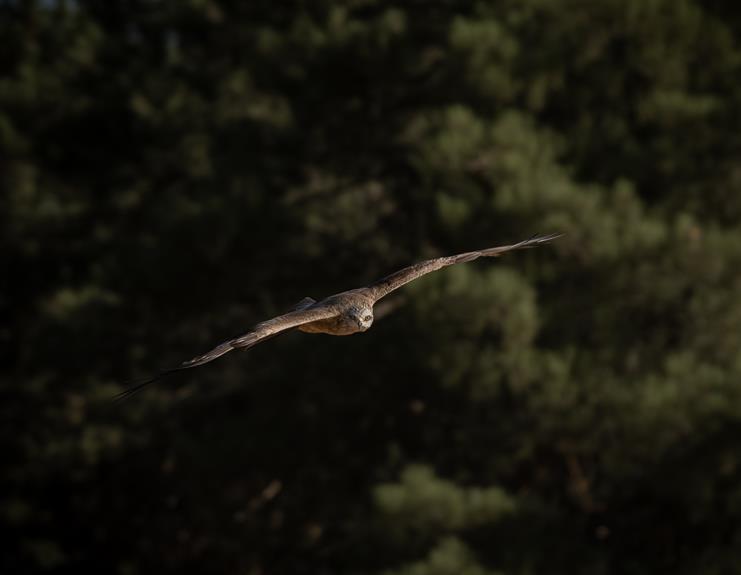Delve into the fascinating world of buzzards, condors, and vultures, as this article uncovers the major differences between these regal avian creatures. With a focus on their classification, habitat, size, predators, and geographic distribution, we embark on a scientific journey of discovery.
Prepare to be captivated by the distinct characteristics and varied habitats of these magnificent birds, as we unravel the secrets of their existence.
Join us as we unravel the mystery of the buzzard, condor, and vulture, shedding light on their unique and mesmerizing traits.
Key Takeaways
- Buzzards, condors, and vultures have distinct habitat preferences and geographic distributions.
- Condors have the largest wingspan, reaching up to 10 feet, while vultures have a wingspan ranging from 5 to 6 feet.
- Buzzards have few natural predators, while condors face threats from humans, and vultures may occasionally fall victim to larger predators.
- Vultures possess a specialized digestive system and strong stomach acids that allow them to consume decaying flesh without getting sick.
Habitat Differences
Buzzards inhabit a variety of open and semi-open areas in Canada and the Americas, while condors thrive in the Andean mountains and desert mountains of Arizona. These different habitats have influenced the feeding habits and physical adaptations of each species.
Buzzards, also known as buzzard hawks, have adapted to their open habitats by developing keen eyesight and a strong sense of smell. This allows them to locate their primary food source, which consists mainly of small mammals, birds, and carrion. Their talons and beaks are well-suited for tearing flesh, enabling them to feed on their prey with ease.
Condors, on the other hand, have adapted to their mountainous habitats by developing a large wingspan and strong flight muscles. This enables them to soar effortlessly in the thermals, scanning the ground for carrion. They have a specialized beak designed for tearing meat, making them efficient scavengers.
Both buzzards and condors play important roles in their respective ecosystems as scavengers, helping to clean up and prevent the spread of diseases. Their habitat preferences and physical adaptations are key factors in their survival and success as vultures.
Size and Predators
Although both condors and vultures are large birds of prey, they exhibit distinct differences in size and predators.
- Size: Condors are one of the largest flying birds, with a wingspan that can reach up to 10 feet, while vultures are slightly smaller, with a wingspan ranging from 5 to 6 feet.
- Predators: Buzzards have very few natural predators due to their large size and powerful beaks and talons. Condors, on the other hand, face threats from humans, who hunt them for sport or capture them for illegal trade. Vultures, as scavengers, are not typically preyed upon, but they may occasionally fall victim to larger predators such as lions or hyenas.
- Feeding habits: Condors and vultures both have a diet mainly consisting of carrion, but condors are also known to hunt small live prey. Vultures rely heavily on their keen sense of smell to locate carcasses from long distances.
- Physical appearance: Condors have a distinctive bald head and neck, while vultures have feathered heads. Additionally, condors have a longer neck and larger wingspan compared to vultures.
- Adaptations: Condors have strong, hooked beaks that allow them to tear into tough carcasses, while vultures have sharp, curved beaks for ripping apart flesh. Condors also have more robust bodies, enabling them to soar effortlessly for long periods.
Geographic Distribution
The geographic distribution of condors and vultures varies significantly across different regions of the world. Migration patterns play a crucial role in the distribution of these birds. Condors, for example, are known for their long-distance migrations, with some individuals traveling hundreds of miles in search of food and suitable breeding grounds.
In contrast, vultures tend to have more localized ranges, often staying within a specific region or habitat.
The ecological role and impact of condors and vultures also differ based on their geographic distribution. Condors, being scavengers, play an essential role in maintaining the ecological balance by consuming carrion and preventing the spread of diseases. They are particularly important in areas where large carcasses are abundant.
Vultures, too, have a vital ecological role as scavengers, but their impact may be more localized due to their more limited range.
Understanding the geographic distribution of these birds is crucial for conservation efforts and ensuring the preservation of their habitats. By studying their migration patterns and ecological impact, scientists can develop strategies to protect these species and their ecosystems.
New World Vultures
New World vultures, including buzzards and condors, are a distinct group of large scavenging birds found in the Americas. These vultures play a crucial role in the ecosystem as scavengers and ecosystem cleaners. Here are some key points about New World vultures:
- Vultures as scavengers:
New World vultures have a unique adaptation that allows them to feed on carrion, or dead animals. They have strong beaks and sharp claws that help them tear through tough animal hides to access the meat. By consuming carrion, vultures help prevent the spread of diseases by removing decaying carcasses from the environment.
- Vultures as ecosystem cleaners:
As scavengers, New World vultures play a vital role in maintaining the cleanliness of their habitats. They efficiently dispose of organic matter, reducing the risk of contamination and promoting nutrient cycling. Furthermore, their feeding habits help control the population of smaller scavengers, such as rats and feral dogs, which can become pests if left unchecked.
- Conservation efforts:
Many New World vulture species are currently facing threats such as habitat loss, poisoning from consuming carcasses contaminated with pesticides, and illegal hunting. Conservation organizations are working to protect these birds and their habitats to ensure their continued contribution to the ecosystem as scavengers and ecosystem cleaners.
- Unique adaptations:
New World vultures have distinct physical characteristics that aid their scavenging lifestyle. They have bald heads, which prevent bacteria and parasites from accumulating in their feathers while feeding on carrion. Additionally, they have excellent eyesight and can locate food from great distances, allowing them to efficiently locate and scavenge carcasses.
- Cultural significance:
New World vultures have held cultural and symbolic importance in various indigenous cultures throughout the Americas. They are often associated with death and rebirth, and their soaring flight has been seen as a symbol of freedom and liberation. The California condor, for example, is considered sacred by some Native American tribes and is an emblematic species for conservation efforts.
Feeding Habits
Buzzards, condors, and vultures' feeding habits are influenced by their role as scavengers in the ecosystem. These birds have evolved feeding adaptations that enable them to efficiently consume carrion.
Vultures, for instance, possess a specialized digestive system that allows them to consume decaying flesh without getting sick. They have strong stomach acids that neutralize harmful bacteria and toxins present in their food. Additionally, vultures have bald heads, which prevent feathers from getting soiled while feeding. This adaptation helps them maintain hygienic conditions and avoid the spread of bacteria.
Buzzards and condors also exhibit scavenging behavior, but they may consume a wider variety of food, including live prey. However, their feeding adaptations are not as specialized as those of vultures.
Physical Characteristics
One notable difference in their physical characteristics is that buzzards, condors, and vultures all possess distinct beak shapes that are adapted for their specific feeding habits. These feeding adaptations are crucial in enabling them to efficiently obtain their food sources.
In terms of flight patterns, buzzards are known for their agile and soaring flight, often gliding effortlessly for long periods. Condors, on the other hand, have a more majestic flight, utilizing thermal updrafts to soar to great heights. Vultures, being scavengers, have a unique flight pattern characterized by their ability to soar low and slow, effortlessly scanning the ground for carrion.
Additionally, vultures possess a keen sense of smell, which aids them in locating food from long distances. Overall, these physical characteristics contribute to the survival and success of each bird species in their respective habitats.
Reproduction and Nesting
Reproduction and nesting play vital roles in the life cycles of buzzards, condors, and vultures, as they ensure the continuation of each species and the preservation of their respective populations.
Mating behavior and nesting habits differ among these birds. Buzzards typically form monogamous pairs and engage in elaborate courtship displays to attract mates. They build nests in trees or on cliffs, using sticks and twigs.
Condors, on the other hand, are also monogamous and engage in courtship rituals that involve soaring and gliding together. They construct large nests on cliffs, using branches and grass.
Vultures, including both New World and Old World species, exhibit varied mating systems. Some form monogamous pairs, while others engage in polygamous or communal breeding. They build nests on cliffs, in caves, or on the ground, using sticks, grass, and other materials.
These differences in mating behavior and nesting habits reflect the unique adaptations and ecological niches of each species.
Conservation Status
Importantly, the conservation status of buzzards, condors, and vultures warrants careful consideration in order to ensure the long-term sustainability of these remarkable bird species. These birds face numerous threats that have led to declining populations in many regions.
Conservation efforts are crucial to protect these species and their habitats. Some key threats to buzzards, condors, and vultures include habitat loss and degradation, poisoning from pesticides and lead ammunition, collision with power lines, and illegal hunting.
Conservation organizations and researchers are actively working to address these threats through various initiatives. These efforts include establishing protected areas, promoting sustainable land-use practices, raising awareness about the importance of these birds, and implementing measures to reduce the use of harmful substances.
Frequently Asked Questions
What Are the Physical Characteristics That Distinguish Buzzards, Condors, and Vultures?
The physical characteristics that distinguish buzzards, condors, and vultures include their large size and scavenging feeding habits. These birds have different habitats and geographic distributions, but all belong to the family Cathartidae.
How Do Buzzards, Condors, and Vultures Differ in Terms of Their Feeding Habits?
Buzzards, condors, and vultures differ in their feeding habits. Vultures are scavengers that primarily feed on carrion, while buzzards and condors have a more varied diet, including small mammals, reptiles, birds, and insects.
What Is the Conservation Status of Buzzards, Condors, and Vultures?
The conservation status of buzzards, condors, and vultures varies. Threats include habitat loss, pollution, and illegal hunting. Conservation efforts focus on habitat preservation, captive breeding programs, and public awareness campaigns to promote the importance of these birds in ecosystems.
Do Buzzards, Condors, and Vultures Have Any Unique Behaviors or Adaptations?
Buzzards, condors, and vultures exhibit unique behaviors and adaptations. These include soaring for long periods, using thermals to glide, and having highly developed olfactory abilities to locate carrion. Additionally, vultures have adaptations to resist bacteria and toxins in their diet.
How Do Buzzards, Condors, and Vultures Contribute to Their Ecosystems?
Buzzards, condors, and vultures play a crucial role in maintaining ecosystem balance as scavengers. Vultures, in particular, are important in preventing the spread of diseases by consuming carrion, thus reducing the chances of infection transmission.
Conclusion
In conclusion, the major differences between buzzards, condors, and vultures lie in their habitat, size, predators, and geographic distribution.
Buzzards and condors are both New World Vultures, belonging to the family Cathartidae, while vultures are divided into New World and Old World groups.
Buzzards inhabit open and semi-open areas in Canada and the Americas, while condors reside in the Andean mountains and the United States.
Both buzzards and condors are sizable birds with few natural predators, while vultures are scavengers and have a wide habitat range.







